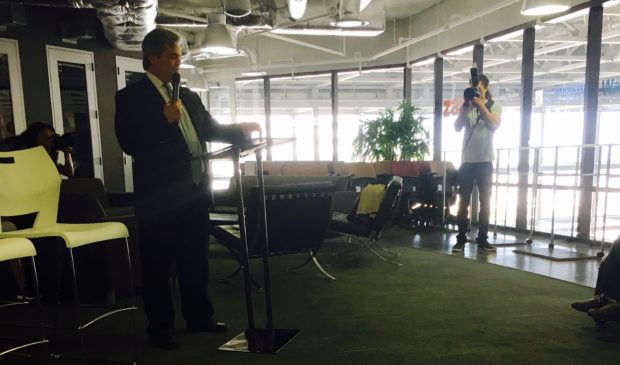CodeNEXT tech talk focuses on familiar topics
Monday, March 27, 2017 by
Chad Swiatecki Planning consultant Peter Park picked an apt way to describe Austin’s current building code while talking to a room full of technology entrepreneurs and stakeholders at Austin’s Capital Factory.
“The (operating system) is kind of broken, and to get the city you want is kind of an arduous process,” Park said of the ongoing reveals and eventual implementation of CodeNEXT, the long-in-coming new city building code. “This process is about fixing a broken system, and it’s imperative that it gets done the right way.”
Park’s comments came last week at an Austin Tech Alliance event – titled CodeNEXT: Will Tech Help Shape the Future of Austin? – that saw Mayor Steve Adler joined by a selection of planning and transportation proponents to weigh out the importance of the new code and what it will mean for housing affordability and the city’s future growth.
The discussion came roughly six weeks after the release of the initial draft of CodeNEXT, and a month ahead of the plan’s maps that most involved in the process say will be key to determining how the plan is changed before it is adopted in 2018.
Adler didn’t mince words, saying at the very top that the draft version of CodeNEXT “is wrong” but that he, City Council and anyone involved in planning for the city’s future are working to make sure it matches up with the Imagine Austin vision of the city’s near future.
The alternative, he said, would see median home values climb past $1 million as they have in San Francisco, after passing the $650,000 threshold of Boston and Seattle.
“That’s the path we’re on, and those are cities that are now consumers of art, not producers of art,” Adler said of housing markets that force artists and creative talents out as prices rise. “If we don’t change any of the rules of the city, we’re headed toward $1.5 million two-bedroom bungalows.”
Adler’s comments didn’t relate much to the event’s stated tech focus, sticking instead to familiar touchstones: The city needs 135,000 housing units over the next decade to meet demand and create affordability, and that the bulk of new construction will have to be focused around transportation corridors delineated in CodeNEXT.
During the panel discussion portion of the event, talk covered planning flaws, including how the city’s current 30-year-old building code enabled redlining and racial exclusion from downtown and West Austin and how showcase developments like Mueller and the Domain would be prohibited by current code were it not for amendments made to the document.
“There’s a layer beneath the buildings that are currently standing that determines what can be built there,” said Niran Babalola, a member of urban activist group AURA. “People who want to put down roots in new places won’t be able to if we keep doing what we have been.”
Also discussed was the large puzzle of plans for building, affordable housing, mobility and other facets of city life that are currently in process at City Hall and other offices throughout Austin.
“They should all inform each other, and I’m excited because lots of things are finally headed in the right direction with the mobility plans like Project Connect,” said John-Michael Cortez, a special assistant to Adler. “The good thing is they’ll all be able to talk to each other.”
All involved said they look forward to the modern planning tools that CodeNEXT will give city staff, developers and other stakeholders to help the city grow in a sensible fashion.
What will be key, Cortez said, is making sure the intent of CodeNEXT isn’t forgotten or that those tools don’t get used in the wrong way.
“This is an opportunity to use (the plan) for ends that are inclusive and progressive to create a more diverse city,” he said. “We’ll never be able to right past wrongs, but we can make progress, and (what) would be truly unfair is if there’s not enough people of color who can afford to choose where and how they want to live.”
The Austin Monitor’s work is made possible by donations from the community. Though our reporting covers donors from time to time, we are careful to keep business and editorial efforts separate while maintaining transparency. A complete list of donors is available here, and our code of ethics is explained here.
You're a community leader
And we’re honored you look to us for serious, in-depth news. You know a strong community needs local and dedicated watchdog reporting. We’re here for you and that won’t change. Now will you take the powerful next step and support our nonprofit news organization?










